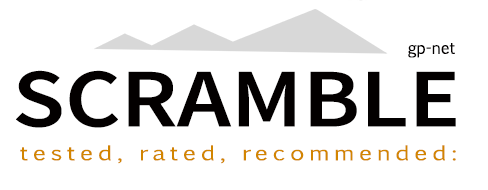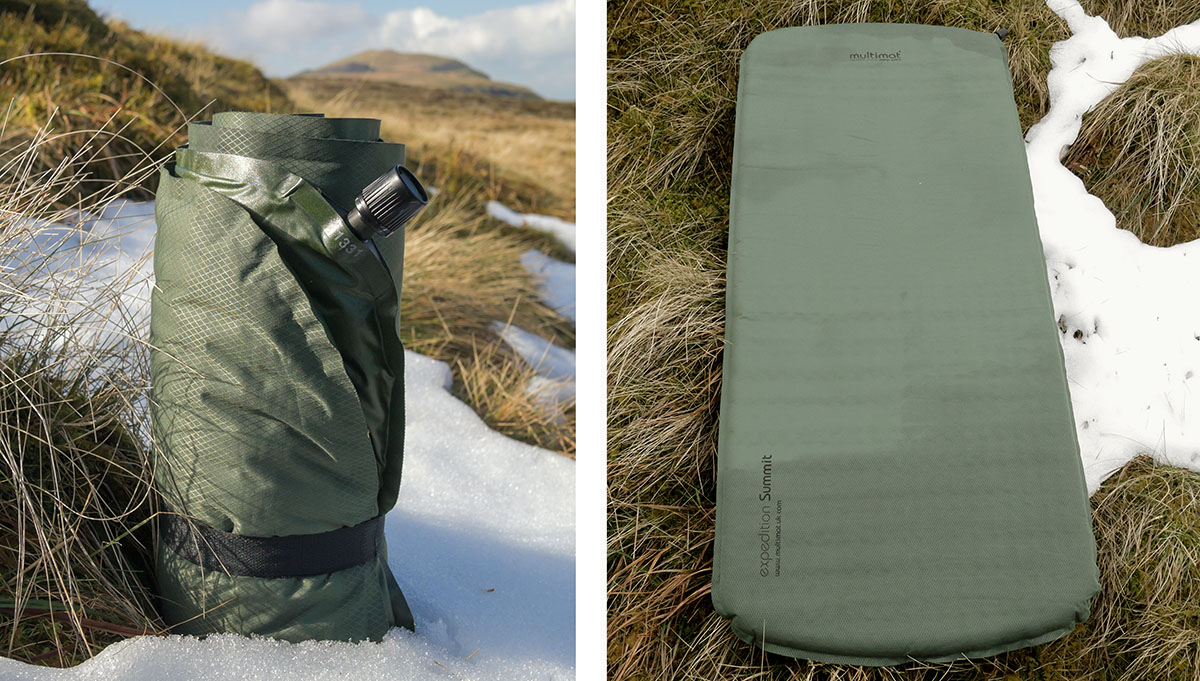Multimat's Expedition Summit Compact 38S Self-Inflating Sleeping Mat
Preface
As always, we're looking at the Multimat Expedition Summit 38S from the point of view of long distance trekking over tough terrain.
Test subject: Height: 5ft 8", Weight 12st 8lbs (80kg)
Test item: Olive Green, Short Length
Kit Tests: Winter
Disclaimer: None required (item not provided by manufacturer)
Datasheet
| Materials (Top Side): 40D Nylon ripstop with silicone non slip coating (Olive or Gold) | 100% |
| Materials (Under Side): 70D Polyester PU non-slip coating (Dark Olive or Black) | 100% |
| Filling: Foam (density = kg / cubic meter) | 16 |
| R-Value (standard measure of insulation - see below) | 0.795 (R-SI) / 4.52 (R-IP) |
| Mat Dimensions (Expanded): Length x Width x Depth | 122 x 51 x 3.8 cm |
| Packed Dimensions: Height x Diameter | 27 x 12.5 cm |
| Weight: Mat Only (Stated / Measured) | 560g / 555g |
| Weight: Official (Microfibre Lined Pillow) Stuff Sack vs. MM Superlite 25S Stuff Sack (incl. 6g Strap) | 63g / 20g |
| Total Weight Measured: (with light stuff sack and velcro strap as pictured below) | 575g |
| Manufacturer RRP* (this is an estimate see here) | £72.00 |
| Scramble's Price on SYSTEM | £57.60 |
Scramble Review
Contents
- Introduction
- Recap: Compromise & Coverage
- Summit 38S Overview
- Materials, Components, Dimensions
- Pack-Size & Weight
- Performance
- Any Negatives?
- Conclusion, Rating & Product Images
- Postscript 1: Non-Standardised R-Values Explained
- Postscript 2: A note on RRP estimate
Introduction
The first section "A Comfortable Compromise" is largely cut and pasted from our review of the Nordisk Ven 2.5. So, if you've already read that review, you already know why compact self-inflating mats are our choice for (unsupported) long distance treks.
Click here to jump into the meat and potatoes of the Summit 38S review.
[Re-Cap] A Comfortable Compromise
The purpose of a sleeping mat is to provide sufficient comfort in the form of cushioning and insulation (from the cold ground) for a good nights sleep. Sleeping mats are on your back during the day, so the lighter the better, but go too light and you'll soon regret the sacrifice. Get the balance right and you'll be well rested without being overly burdened.
There are basically three types of sleeping mat:
- Closed-Cell Foam Mats
- Inflatable Air Mattresses
- Self-Inflating Mats
In simple terms, so-called "self-inflating" mats (which generally don't really self-inflate, though the Summit 38S and Multimat's NATO mat are exceptions) are a cross between (1) and (2). This means you get some of the foam-based insulation from (1) and some of the comfort from (2). Self-inflating mats pack down much smaller than closed-cell foam mats, and require much less air to blow up than air mattresses.
There are plenty of guides (such as this one from AlpineTrek) that detail the various pros and cons of each type, so we won't go into that here. Instead, we'll just state that Scramble exclusively use short-length, self-inflating mats - a thicker, heavier duty one (reviewed below) for sub-zero temperatures and a lighter one for temperatures above freezing.
Coverage [Re-Cap]
The standard length for a regular full size sleeping mat is 183cm. The Summit 38S is 122cm long, so short really means a "two-thirds length mat", which is quite sufficient:
Assuming we can muster a pillow from our assortment of baselayers, softshells, insulated jackets and a dry bag (or even better, a Tower), we can ignore the head and upper neck issue. The remaining bony areas of the body that really appreciate some cushioning are the hips, shoulders and back. So, to keep the weight to a minimum, a short-length (2/3) mat is really all that's required. For most people, 122cm will cover shoulder to at least lower thigh.
"What about my knees and feet!" Poor you! Well, if that's really a problem you can simply use your pack to provide some additional support and insulation for your lower legs and in winter this is precisely what we do. So, a short mat plus pack is all you really need tucked under your sleeping bag for a good nights sleep.
With that out of the way, let's look at the excellent Summit 38S.
The Expedition Summit 38S: A Brief Overview
The Summit 38S is one of the unsung heroes of our winter gear. It's a stellar performer; an unfussy, simple bit of kit that rarely draws attention to itself. It's easy to feel its effect (when you've slept like a baby, you're warm and comfortable and it's dark and freezing outside) but all too often the womb-like warmth of the sleeping bag steals your attention and the workhorse sandwiched between your sleeping bag and the cold, cold ground goes unnoticed.
It's hard (no, impossible) to find a sleeping mat that offers the degree of insulation (R-Value = 4.52, Tog = 7.95), durability, low weight and small pack-size of the Summit 38S, without spending well over £100. Two well regarded, full length (air-pad), models (filled with this insulation or that technology) offer competitive specs, but at a hefty price:
- Exped SynMat HL Winter, which offers similar specs for insulation and weight, but dubious durability (20D polyester) and retails for £165.
Then, probably the best of its kind, the noisy - Therm-a-Rest's NEOAir Xtherm, which is lighter (500g incl. pump) and will be warmer, but costs £185 (RRP). That's a lot of money for something that might go pop.
One of the issues with air-pads is convection. You want to limit the degree air can flow freely within its container. The more you move on an air pad, the more you pump the air around within it; the air heated by your body, circulating freely, will come into contact with the cold surface next to the ground and cool.
This illustration from the Building Science Corporation's report "When R-Value Doesn’t Measure Up (PDF)" captures it quite well. Scenario (b) being relevant to lightly insulated air-pads:
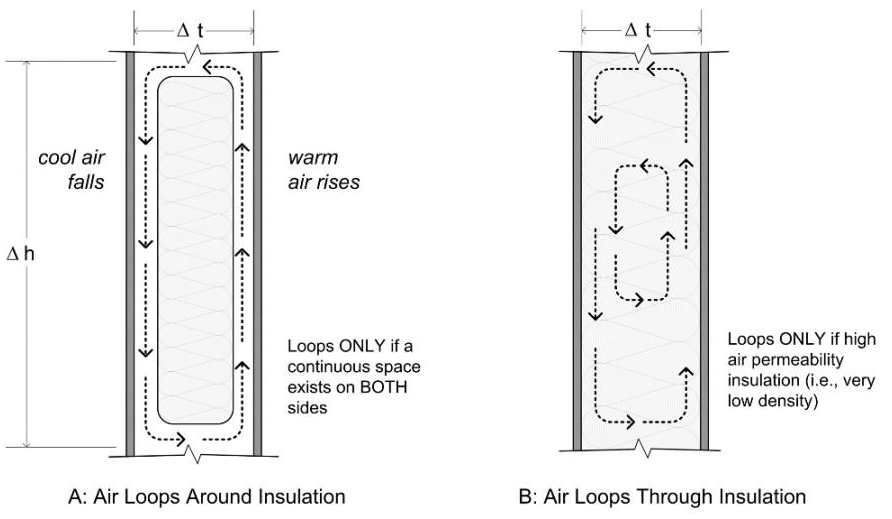 Image copyright Building Science Corporation
Image copyright Building Science Corporation
The Summit 38S is filled with dense (16kg / cubic meter) vertically and horizontally drilled foam cores and this matrix of foam helps to still circulating air (as well as support the sleeper), so there is less heat-loss via convection. In addition, the mid section provides a "warm zone" for the torso which offers increased insulation and support.
Ultimately, what makes the Summit 38S so good is that it offers relatively light-weight durability and solid cold-weather performance without bankrupting you in the process.
Let's see how Multimat made a cold-weather masterpiece that, rather like this farewell transmission, too few appreciate(d).
Materials, Components, Dimensions
Top-Side
The upper surface is made from a light but durable 40D ripstop nylon (not polyester, like many), which has a non-slip, water-resistant silicone coating applied. It feels robust and it is; we've had no issues with any of these mats over years of use.
 The Summit has a durable top surface made from a coated 40D nylon.
The Summit has a durable top surface made from a coated 40D nylon.
Under-Side
Flipped over, the Summit 38S has a heavier duty 70D PU coated polyester base fabric which is both non-slip and waterproof. This ensures that errant moisture doesn't get into the foam insulation and cause mould to form and degradation to follow.
You'll notice, the Summit is more rectangular than many designs which often have highly (near oval) rounded-off corners. Further, unlike many air-pads which have rounded cylindrical chambers and steep walls (where the usable width may be more like 47cm), with the Summit you get the full 51cm width to sleep on.
 The Multimat Summit 38S has a waterproof non-slip base made from PU coated 70D polyester.
The Multimat Summit 38S has a waterproof non-slip base made from PU coated 70D polyester.
Below is a closer view of the Summit's two distinctly different surfaces.
The total depth of the Summit 38S is in its name: 38mm or 3.8cm. The Summit 38S provides very stable support and doesn't yield much at all under load. In terms of comfort, if you need any more than what the Summit provides ... well, I hear they're auditioning for "The Princess and the Pea".
A little like sleeping on a futon, with the Summit 38S, you're not bouncing around in your sleep or rolling off the edges as you might on an air-pad. Very simply, it's exceptionally comfortable.
 The Summit is 38mm thick with a dense vertically and horizontally drilled foam core.
The Summit is 38mm thick with a dense vertically and horizontally drilled foam core.
The Valve
There aren't many features on a sleeping mat, the few there are tend to be quite important. This is certainly the case with the valve and also its housing (sealing). The valve on the Summit 38S is superb. A short twist will lock (or unlock) it, sealing in the air. When the valve is extended you can inflate; after each breath, simply pushing in the valve provides a temporary seal before your next exhale. Once fully inflated, push in and twist and it's locked and sealed. Once sealed, I've never woken up with a Summit that had deflated even slightly. Multimat say they individually test these mats as part of their QC.
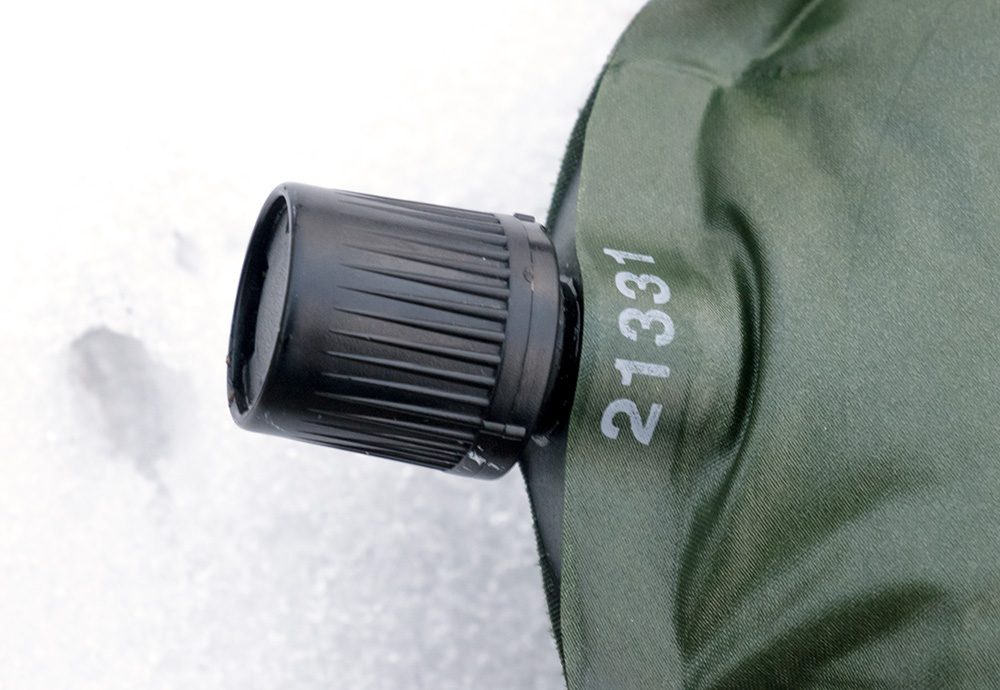 Multimat's excellent valve on the Summit 38S is one of the highlights.
Multimat's excellent valve on the Summit 38S is one of the highlights.
Unlike many lighter-weight self-inflating mats, due to its dense compact foam, the Summit 38S does indeed self-inflate. I generally can't be bothered to wait, but if you want to, you can just unroll it and let it sit and it will suck in air to the point where you just need a single breath or possibly two to inflate it fully. Four or five long breaths should be enough to inflate the Summit when inflating from scratch.
Pack-Size & Weight
The Summit 38S comes with an equally heavy duty stuff sack (~60g) with a microfibre lining, allowing it to double as a pillow. Personally, I leave this at home and use an old stuff sack (<20g) that came with a Superlite 25S mat from Multimat, but any lightweight stuff sack would do. This substitution brings the total carry weight down to 575g.
To pack up the Summit, fold it down the middle with the nylon, top-side on the outside. It packs down to a reasonably tidy package: around 27cm tall and ~12.5 cm in diameter.
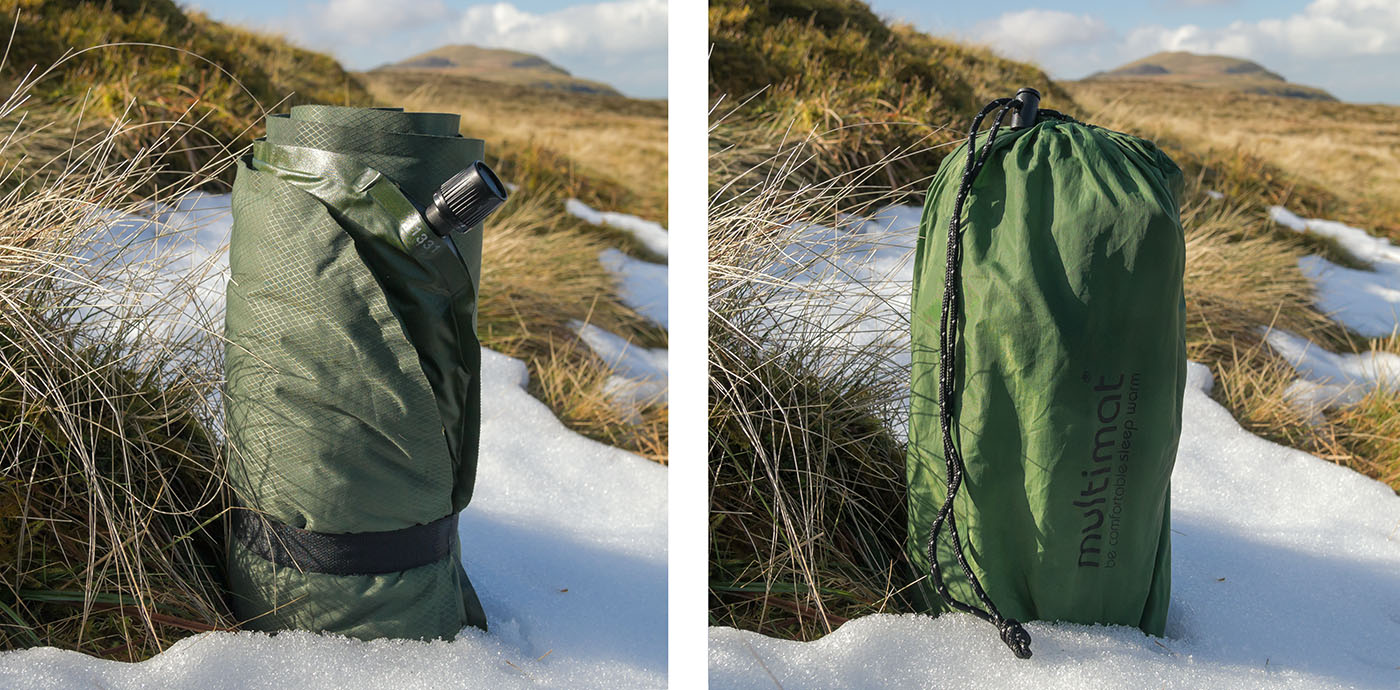 The Multimat Summit 38S is a breeze to pack away and doesn't take up too much room in the pack.
The Multimat Summit 38S is a breeze to pack away and doesn't take up too much room in the pack.
Performance
Temperature
We've tested the Summit 38S down into the -20s°C, I've personally used it into the mid-teens (~ -15°C). Its components are rated for operation down to -35°C. If you're going to use the Summit 38S much below -20°C, I'd recommend pairing it with a closed cell foam mat like the Nemo Switchback (R-Value = 1.9) or the lighter Exped FlexMat (R-Value = 1.5). This would bring up the total insulation to an R-Value of around 6.0 to 6.5 which (depending on the user's sleeping bag, metabolism and a host of environmental factors) should get you down to around -30°C.
A Good Night's Sleep?
In the last winter kit test (2020), which began with the onset of one of those named storms, I slept like an absolute log. This is in large part to the Summit 38S, but also the Bush Cocoon, the Defence 4 sleeping bag and comfortable sleepwear options.
I've never had a time, when I've woken up and been cursing the Summit 38S. I've had some sleepless nights, but the Summit 38S has never been the cause. As I stated earlier, it's been one of those items that just quietly does its job, and does it outstandingly well.
Any Negatives?
The only negative we can come up with is not actually directed at the Summit 38S, but rather its manufacturer's decision to cease producing it. Often when manufacturers make an outstanding product but do not sell enough to make them a viable item to produce, we can't help but feel that's a failure of communication on their part.
We've done our best here to help explain why this kind of product needs to be made; we hope one day Multimat will revisit this. There's nothing wrong, in our opinion, with explaining to people the problems inherent in the competition's products, especially if you have a superior offering.
The Summit 38S can still be purchased (we've managed to secure a small number) but it's discontinued by Multimat and has been replaced by the (NSN 8465-99-310-9203 mil-spec) NATO mat, which though insanely durable and probably bullet proof, is substantially heavier (725g) and provides significantly less insulation (R-Value = 3.01 vs 4.52). There is a full length version of the Summit 38S, called the Summit 25/38, but for Scramble at least, it's too heavy (weighing in at 760g).
As per our default approach, this review will stand until we find a replacement that is as good or better. We may have to be patient.
Conclusion & Rating
Multimat certainly knew what they were doing when they made the Summit 38S, perhaps their only failure was effectively conveying its properties to the outdoor community. I'm often surprised how few understand that, in most cases, a full length sleeping mat is unnecessary. There's plenty of stuff (like your backpack, clothing etc ...) that you can slide under the final quarter or third of your sleeping bag.
The Summit 38S is supremely comfortable and offers a high degree of insulation from the freezing ground. Non-slip silicone and PU coatings provide a water-resistant top-surface and a genuinely waterproof base while ensuring the mat isn't sliding around inside your tent or slipping out from under you like a bar of soap. Unlike air-pads, the self-inflating Summit has a flat upper surface, ensuring its full stated width is available to the sleeper. A stand-out feature is the excellent (removable) valve that provides a reliably secure seal and makes inflation hassle free.
The Summit 38S combines relatively light-weight durability, luxurious comfort and outstanding cold-weather performance at the kind of price that should scare (or should have scared) the Expeds and Cascade Designs of this world. Practically faultless in both design and performance, the Multimat Expedition Summit Compact 38S is Scramble's top pick in the Cold Weather (Sub Zero) Sleeping Mat category.
Product Images
Rating (out of 10)
* The value score is derived from two factors:
1) Competitive Market Price (CMP). This represents our judgement of a competitive online price point if we were to stock the item. e.g. if we feel we would need to sell an item at 40% off (i.e. 60% of its full RRP) to be competitive, then our CMP score will be 6/10.
2) Customer Value Price (CVP). We then make an honest appraisal of the maximum price we would be willing to pay for the item (and we're mean). So if we'd pay 80% of its RRP our CVP score would be 8/10.
We then average the two scores to get our final value score, which in our example would be 7/10.
Postscript 1: Non-Standardised R-Values Explained
The standard measure for insulation is the R-Value. In simple terms, the higher the number the greater the insulation. However, and very significantly, this measure is NOT internationally standard. For example, the UK, Australia and NZ all use R(SI) which is metric and the US and Canada use R(I-P) which stands for Inch-Pound which is imperial. The R(I-P) Value is 5.68 times larger. So simply put, if you see an R-Value above 1.0 it's very likely using the R(I-P) measure and not R(SI). The table below is useful, so at Scramble we convert all R(SI) values into R(I-P) and in the datasheet (above) quote both.
The Nordisk Ven 2.5 has a quoted R-Value of 2.3 which means they're using the R(I-P) measure.
Manufacturers like Multimat use the Tog rating to get around this confusion. To convert Tog to R(SI) you simply divide by 10. So a Tog value of 5 converts to 0.5 R(SI).
To make this as clear as possible, we'll use a real world example and compare the Ven 2.5 to Multimat's Expedition range Summit 38S mat, which we recommend and use for sub zero treks. The Ven 2.5 has a quoted R(I-P) of 2.3. The Summit 38S has a Tog Value of 7.95. Let's see how they compare:
- Tog > R(SI) Conversion: 7.95 / 10 = 0.795
- R(SI) > R(I-P) Conversion: 0.795 x 5.68 = 4.52
So the Summit 38S (4.52 R-IP) is about twice as warm as the Ven 2.5 (2.30 R-IP) which makes sense and corresponds to our experience. Now we can use this useful table (from GearX.com) to see their operating ranges:
As you can see the Nordisk Ven 2.5 (R=2.3) is easily adequate for temperatures above freezing and the Multimat Summit 38S (R=4.5) is good down to around -30°C.
Hopefully that clears things up. If you want more background on the kinds of confusion this causes, Multimat have an excellent article entitled: "Don't be fooled by over-inflated R-values".
Postscript 2: RRP Estimate Explained
The Summit Compact 38S is no longer made by Multimat (though we've managed to secure a small number) and so to get a relevant current RRP for this model, we've looked through the Multimat range and checked the percentage price difference between their compact (S) models and their regular full length models. We've then applied this reduction (which is consistently ~80%) to the current RRP for the Expedition Summit 38 full length model (£90). The resulting RRP (for 2020) comes to £72.00. Which makes sense in light of their NATO model (£65 RRP) which though insanely durable, is substantially heavier and provides significantly less insulation.
Last Updated: 04/04/20
